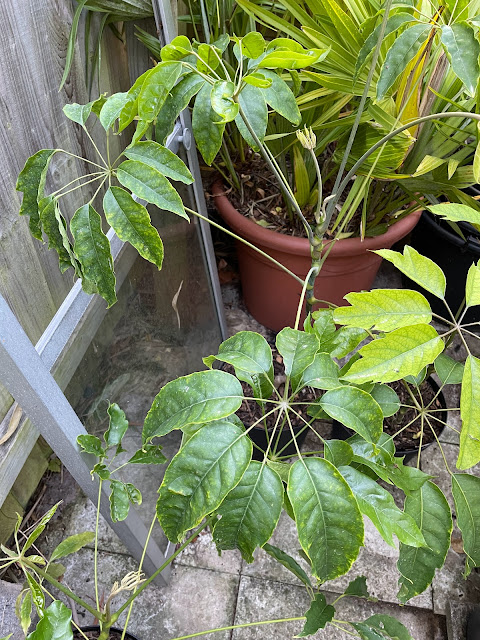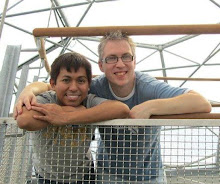Monday, June 27, 2022
Scheffleras from Taiwan
Wednesday, June 22, 2022
Fixing What Ain't Broken
The hard landscaping of our top patio has pretty much been unchanged since we moved into our place back in 2005. The paving is composed of mainly thick concrete paving slabs and bricks arranged to a pattern. It's not the most elegant nor impressive of materials but they were laid solidly, aged well, and served the purpose. Having just moved into this property then, the priority for both budget and time was to sort out the house rather than the hard landscaping of the top patio. It wasn’t broke so why fix it?
 |
| As it was until last weekend |
Through the years it had been playing in our heads to eventually upgrade the paving to real stone. But as it wasn’t changed early on, the patio has since filled with plants and pots as we also carried on sorting the rest of the garden.
It would be wonderful if we were to change the paving to all stone now (a herringbone pattern would be nice!). But the idea of shifting all those pots to one side and having to deal with the mess and disruption for months on end didn't sound appealing either. Plus you put all that stone down only to cover more than half of it in pots seemed counterproductive. So we decided on a compromise...
Instead of lifting and changing everything, we'll concentrate on the pathway of the existing layout instead. With a little dose of creativity, we opted to use mix shades of sandstone to replace concrete paving slabs along the pathway, laid out to look random and planned at the same time.
We already have a plan for the old slabs but that will be revealed in due course :)
It'll be a relatively easier job to do this way, with only having to lift a few paving slabs at a time and not having to shift so many pots along the way. It should give the patio a bit of an upgrade and provide extra interest.
It's a work in progress at the moment and we’ll post photos once the work is finished, fixing what ain’t broken.
Mark :-)
Saturday, June 18, 2022
Palm House at the Garfield Park Conservatory
Continuing on from our previous post regarding the Fern House at Garfield Park Conservatory is a feature on the first section you'll see when you go in the conservatory: the Palm House.
The vignette of palms and related complementary understory planting that greets you is a fantastic preview of what else is in store...
 |
| Palm House at Garfield Park Conservatory |
Much like the Fern House, the path divides into two that will lead you into the other portions of the conservatory. The Palm House, as it's namesake suggests consists of a collection of tropical and subtropical palms of great architectural merit. Under the care of their horticultural team, they are all looking very healthy and for most towering with huge leaves.
In contrast to the Fern House however, the understory planting is less naturalistic but more manicured and formal, much like what you'll see in private gardens, parks, and show gardens. They have generously used bromeliads and other colourful planting in a more coordinated fashion, to a stunning effect.
Mark :-)
Thursday, June 16, 2022
Aroid House at the Garfield Park Conservatory
The Garfield Park Conservatory has several botanical sections with the Palm House and Fern House occupying the largest spaces. The smaller ones are no less remarkable and the best of the smaller sections is the Aroid House. Let's have a look:
 |
| Aroid House at Garfield Park Conservatory |
As the name suggests, this section is all about different kinds of aroids, planted together for a beautifully naturalistic and cohesive display. It is a showcase of different leaf sizes of aroids, from the minute to the largest, together creating a lush, jungle feel.
Wednesday, June 15, 2022
Favourite Plant of the Week - Cyphomandra corymbiflora
Cyphomandra corymbiflora, sometimes called a hardy tree tomato, has been growing in our garden for well over a decade, going through the poor winter of 2010. We have found it pretty tough, although a very late frost last year did it some damage. Fortunately it recovered - fairly late in the season - and a mild winter for 2021-22 has helped it on its recovery.
At this time of year it starts to put on its display of blooms, one of just a handful of plants flowering in the garden despite the season, we missed this display last year as it was in recovery mode but its back.
We grew this one from seed, i think we had a fairly good germinations rate but only kept one plant for ourselves. Where its been planted in a relatively shady spot, with quite a lot of competition.
Tuesday, June 14, 2022
Side Passage Makeover
Last weekend we took on a mini project by making over the side passage of the house that leads on to the garden. It had a partial makeover before, when we sorted out the planting halfway through this narrow passageway nearest to the house. But the area adjacent to the conservatory leading towards the top patio only received further attention in the last few days.
 |
| New planting on the garden side passage |
 |
| Existing planting on the side passage, done many years ago |
Thursday, June 09, 2022
Fern House at the Garfield Park Conservatory
A glimpse of what Illinois may have looked like 300 million years ago. That was the vision of landscape architect Jens Jensen when he conceptualised the Fern House within Garfield Park Conservatory in Chicago, Illinois. The plans were made in 1906 and opened to the public in 1908 much to the delight of locals and visitors alike. It was reported to have been a sensation...
 |
| Fern House at Garfield Park Conservatory |
Monday, June 06, 2022
Hosepipe and Secateurs
Saturday, June 04, 2022
Quick Trip to The Palm Centre
On our way to Kew Gardens last Thursday we popped round to The Palm Centre first as we always did in the past. We haven't been to Kew Gardens for four years and even more so to The Palm Centre, as our last Kew visit was by train not by car as we tend to do. So we were extra curious as to how it is looking now after not seeing it for so many years.
Turns out it still pretty much the same but as expected there have been some rearrangements of display areas and they stock a lot more houseplants than they used to. Let's have a look...
 |
| Trachycarpus oreophilus |
 |
| Jubaea chilensis to the left, planted out here for over two or even three decades already |
As you come in on the driveway you are greeted with specimen palms for sale. They are geared for both the public and landscape gardeners needing specimen planting. As you can see from above they have a range of large Butia capitata, Jubaea chilensis, Chamaerops humilis, Chamaerops humilis var. cerifera among others. They also have a Trachycarpus display bed to the left of the driveway showing the different species in their collection, and the second photo above is Tracycarpus oreophilus.
There is a large outdoor retail section at the back where more specimen palms for sale can be found, as well as a range of bamboos, trees, shrubs, and some Dicksonia antarctica tree ferns (rounbd £90 per foot)
On the borders of this section are also a range of exotic plants permanently planted out to showcase how they behave with a free root run, established, and thriving outdoors.
 |
| Trichocereus terschekii |
On to the greenhouses and above are their range of cacti and succulents for sale. Most notable above are the Trichocereus terscheckii which seemed reasonably priced at that size for £99. This is te same cactus growing permanently outside by our front door and I'm aware of several private exotic gardens in the UK have this permanently planted out all year round.
 |
| Trichocereus terschekii |
And even more Trichocereus terscheckii spotted along the way, this time bigger specimen plants for instant impact. They also a range of tree aloes with Aloidendron barberae on the third photo above and some other agaves and other succulents.
And as seen above, they have a much bigger range of houseplants for sale than ever was years ago. It is very trendy now and there are a lot of flats/apartments in the area so is a lucrative market for them to tap in to.
And a few more odds and ends as seen above, including a glimpse of their outdoor herbaceous perennial retail area.
So what did we buy? Not much really but you can't walk out of the Palm Centre after so many years without buying a palm so we bought a small Butia odorata (ex. capitata) for growing on, an Asplenium bulbiferum for the jungle veranda, and Nandina domestica in their bargain corner as a filler plant.
So off to Kew Gardens we go which will feature in a future post.
Mark :-)
















































 This gardening blog follows our journey as we create our Tropical and Exotic themed garden. We hope you'll enjoy the journey as much as we do. We started our Exotic Garden in 2005 and this site will show its development, as well as our travels, both abroad and within the UK to gardens, nurseries and friends.
This gardening blog follows our journey as we create our Tropical and Exotic themed garden. We hope you'll enjoy the journey as much as we do. We started our Exotic Garden in 2005 and this site will show its development, as well as our travels, both abroad and within the UK to gardens, nurseries and friends.











